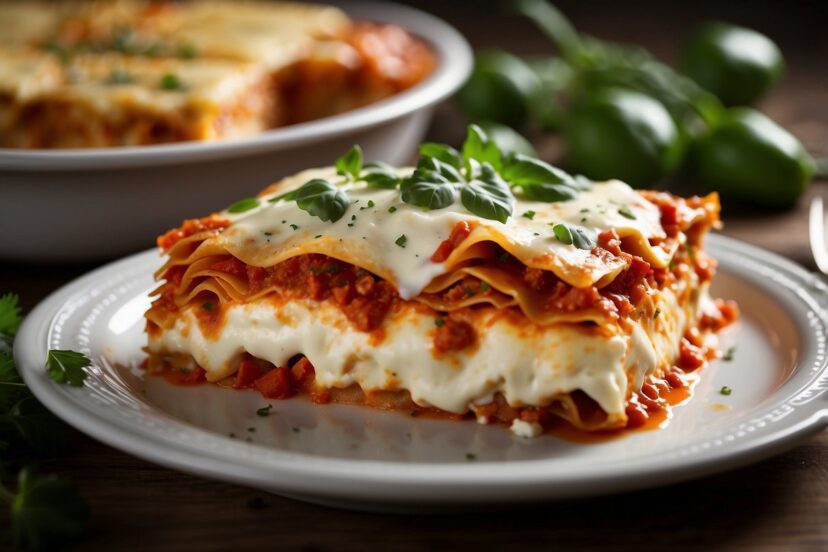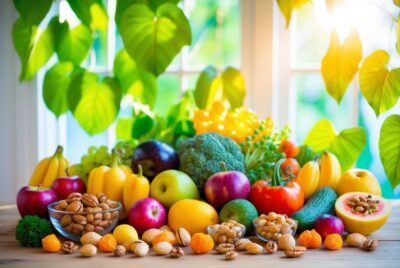Vegetarian Lasagna Recipe: Perfect for Any Occasion
*We may earn a commission for purchases made using our links. Please see our disclosure to learn more.
Vegetarian Lasagna Recipe: Perfect for Any Occasion
Creating a tasty vegetarian lasagna recipe isn’t just about skipping the meat—it’s about packing in flavor with fresh, vibrant veggies and rich cheeses. This recipe combines hearty vegetables like zucchini, spinach, and mushrooms with creamy ricotta and tangy marinara, ensuring every bite is satisfying and delicious.

Whether you are a seasoned chef or a beginner in the kitchen, my straightforward steps will guide you to a nutritious and comforting meal that even meat lovers wouldn’t want to miss. Plus, with no-boil noodles, this dish is both easy to prepare and perfect for busy weeknights.
So, let’s dive in and craft a vegetarian lasagna that is not only simple to make but also irresistible to eat.
Essential Ingredients

When making vegetarian lasagna, selecting the right vegetables, cheeses, and pasta types is crucial. Each ingredient adds unique flavors and textures, leading to a delicious and well-balanced dish.
Choosing Your Vegetables
The vegetables in a lasagna bring both taste and nutrition. I often use a mix of zucchini, eggplant, bell peppers, and spinach.
Sautéing vegetables before adding them to the lasagna softens them and enhances their flavors.
For example, zucchini and eggplant become tender and slightly caramelized when cooked. Spinach and bell peppers add vibrant color and a fresh taste.
Be sure to chop the vegetables into small, even pieces so they cook evenly.
You can also experiment with other vegetables like carrots, mushrooms, and celery to add more variety and depth to the dish.
Types of Cheese
Cheese is essential for a hearty and creamy texture. I like to use a blend of different types of cheese:
- Mozzarella: Provides a melty and stretchy texture.
- Parmesan: Adds a salty and nutty flavor.
- Ricotta: Offers a creamy and slightly sweet taste.
Using a combination of these cheeses ensures a balanced flavor profile.
Ricotta is typically layered with spinach and herbs, while mozzarella and parmesan are sprinkled on top for a golden, bubbly finish.
If you prefer a lower-fat option, you can substitute part-skim ricotta and low-moisture mozzarella. Fresh herbs like basil and oregano can be mixed into the ricotta to enhance its flavor.
Varieties of Pasta
The pasta you choose affects the dish’s structure and texture. Traditional lasagna uses lasagna sheets, which are wide and flat.
These sheets work well for layering ingredients.
There are two main types: no-boil and regular. No-boil lasagna sheets save time, as they cook in the oven with the sauce. Regular lasagna sheets need to be pre-cooked before layering.
You can also consider whole wheat or gluten-free pasta for dietary preferences. Whole wheat pasta offers a slightly nutty flavor and extra nutrients, while gluten-free pasta is perfect for those with gluten sensitivities.
Each type of pasta has its unique qualities, so choose one that matches your cooking style and dietary needs.
Preparation Techniques

When making a vegetarian lasagna, the way you prepare your vegetables and cheese can greatly impact the final dish. Properly slicing vegetables ensures even cooking, while effective cheese grating maximizes flavor distribution.
Slicing Vegetables
Slicing vegetables correctly is key for a well-cooked lasagna. I usually start by washing all the vegetables thoroughly.
- Spinach: I prefer to use fresh spinach, loosely chopping it.
- Mushrooms: Thin, even slices work best.
- Zucchini and Bell Pepper: I slice these into thin rounds or strips.
When sautéing, I use medium-high heat and a little oil. Cooking the vegetables for about 10-15 minutes helps to release their flavors and remove excess moisture. This step prevents a soggy lasagna.
Cheese Grating Tips
For the cheese, I find that freshly grated cheese offers better meltability and taste compared to pre-packaged options.
- Ricotta: This cheese doesn’t need grating. Instead, I mix it with egg and Parmesan for a creamy layer.
- Mozzarella and Parmesan: For these, I use a medium or fine grater.
Freshly grated cheese distributes more evenly and melts better, enhancing the lasagna’s texture. Additionally, using Parmesan in the ricotta mixture adds a nutty flavor that complements the vegetables well.
Vegetarian Lasagna Recipe: Layering the Lasagna

Layering the lasagna properly ensures each bite is full of flavor and texture. Here’s how to create the perfect layers, including the specific order of ingredients and tips for even layers.
Order of Layers
First, I preheat the oven to around 375°F (190°C). I start by spreading a thin layer of tomato sauce on the bottom of a 9″x13″ baking dish. This prevents the noodles from sticking.
Next, I add a layer of lasagna noodles. It’s important to leave a little space between them as they’ll expand while cooking. If the noodles don’t fit perfectly, I snap off the ends to make them fit.
After that comes half of the ricotta or cottage cheese mixture. I spread this out evenly over the noodles. Then, I add half of the roasted vegetables, like spinach or zucchini, followed by another thin layer of sauce.
I repeat the process: noodles, cheese mixture, vegetables, and sauce until I run out of ingredients. I finish with a layer of noodles, topped with the remaining sauce and a generous amount of shredded mozzarella or Parmesan cheese.
Tips for Even Layers
To ensure even layers, I spread each ingredient carefully across the entire surface. Using a spatula helps in achieving thin, uniform layers.
For the cheeses, I use a spoon or spatula to spread them out evenly. A little extra care here can make a big difference in the final texture.
I also recommend roasting the vegetables in advance, as this can enhance their flavor and make them easier to layer. Drizzling a bit of olive oil between layers can help distribute flavors and prevent unwanted dryness.
Finally, I let the assembled lasagna rest for about 15 minutes before baking. This allows the layers to settle and makes slicing easier later on.
Baking Instructions for this Vegetarian Lasagna Recipe

To make sure your vegetarian lasagna turns out perfectly, follow these specific instructions for preheating the oven and deciding whether to bake it covered or uncovered.
Preheating the Oven
Preheating your oven is crucial for baking lasagna. First, set your oven to 425 degrees Fahrenheit. This ensures that the lasagna will cook evenly and the cheese will melt beautifully. While the oven is heating, you can finish assembling your lasagna to make the most of your time.
Make sure your oven rack is in the center position. This allows for even heat distribution, which is essential for a dish like lasagna with multiple layers. An oven thermometer can be helpful to confirm your oven reaches and maintains the correct temperature.
Covered vs. Uncovered Baking
Deciding whether to bake your lasagna covered or uncovered is important. For the first part of baking, it’s best to cover the lasagna with aluminum foil. This helps retain moisture and prevents the top layer from browning too quickly. I usually cover mine with a sheet of foil sprayed with a little cooking spray to prevent sticking.
After about 20-30 minutes, remove the foil. This allows the top to get a nice golden brown and any cheese to become bubbly. Keep an eye on it to ensure it doesn’t burn. Adjusting between covered and uncovered baking ensures both a moist interior and a deliciously crispy top layer.
Serving Suggestions for a Vegetarian Lasagna Recipe

Vegetarian lasagna is a versatile dish that pairs well with various garnishes and sides. Thoughtful additions can elevate its flavor and presentation.
Garnishing Ideas
I like to top my vegetarian lasagna with fresh herbs. Basil, parsley, and thyme add a pop of color and freshness. A sprinkle of grated Parmesan cheese also enhances the flavor.
Drizzling a bit of balsamic glaze over each slice can add a sweet tang. For some extra crunch, I sometimes scatter toasted pine nuts on top. These small touches make the dish not just tasty but also visually appealing.
Pairing with Sides
A simple garden salad pairs wonderfully with lasagna. Mixed greens, cherry tomatoes, and a light vinaigrette balance the richness of the lasagna. I often include a side of garlic bread for a bit of crunch and additional flavor.
Roasted vegetables, such as broccoli or Brussels sprouts, are also excellent accompaniments. They provide a lighter, healthier contrast to the cheesy lasagna. Finally, I often serve a crisp, refreshing sparkling water or a light white wine to complement the meal.
Frequently Asked Questions
Here are answers to some common questions about making a delicious vegetarian lasagna. These tips cover everything from ingredient substitutions to preventing watery lasagna.
1. What can I substitute for meat to make a vegetarian lasagna both hearty and flavorful?
You can use ingredients like mushrooms, lentils, or a mix of roasted vegetables. Mushrooms add a meaty texture. Lentils provide protein and bulk, and roasted vegetables add depth of flavor.
2. How can I prevent my vegetarian lasagna from being too watery?
To avoid a watery lasagna, make sure to pat the veggies dry before cooking them. Cooking the vegetables thoroughly can help evaporate excess moisture. Also, avoid overly watery sauces and let the lasagna rest before serving.
3. Which vegetables are best suited for adding to a vegetarian lasagna?
Great options include zucchini, bell peppers, carrots, spinach, and mushrooms. Each of these vegetables adds its own unique flavor and texture, making for a more interesting and tasty dish.
4. How can I incorporate spinach into a vegetarian lasagna recipe?
You can mix spinach with ricotta cheese and layer it in the lasagna. Sauté fresh spinach until wilted or use frozen spinach that’s been thawed and drained well. Mix it with ricotta cheese, nutmeg, salt, and pepper for a tasty layer.
5. Can you make a vegetarian lasagna with a creamy white sauce instead of a tomato-based sauce?
Yes, you can use a béchamel or Alfredo sauce for a creamy white lasagna. Prepare a simple béchamel by whisking together butter, flour, and milk until thickened. This will give your lasagna a rich and creamy texture.




